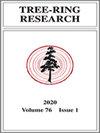Using Dendroecology to Strengthen the Historic Integrity of Cumberland Homesteads Tower in Crossville, Tennessee
IF 1.1
4区 农林科学
Q3 FORESTRY
引用次数: 0
Abstract
ABSTRACT The Cumberland Homesteads Historic District, located on the Cumberland Plateau in East Tennessee, is home to one of the first and largest Homesteads projects attempted during the New Deal era. Although the settlement did not succeed in its original objective, the history of the Cumberland Homesteads has become a valued foundation of the local community, which in turn strives to protect the legacy of the Cumberland Homesteads Tower. To preserve the integrity of the structure as well as the historical integrity of the landscape, the Cumberland Homesteads Tower Association sought to date and potentially remove trees that were not present during the period of significance (prior to 1938). The majority of the trees in close proximity to the Tower were identified as Eastern hemlock (Tsuga canadensis (L.) Carrière) and 15 trees total were sampled. Additionally, three post oak (Quercus stellata Wangenh.) trees located in a historic ‘triangle’ across the highway from the Tower and targeted for removal were sampled. Samples were successfully dated, and ca. half of the hemlock were confirmed to have been planted after the construction of the Homesteads Tower. Additionally, post oaks analyzed near the Tower were dated back to the early 1800s, which motivated their protection in the midst of a road project threatening their survival.利用树木生态学加强田纳西州克罗斯维尔坎伯兰宅基地塔的历史完整性
坎伯兰宅地历史区位于田纳西州东部的坎伯兰高原,是新政时期第一批也是最大的宅地项目之一。虽然定居点没有实现其最初的目标,但坎伯兰宅地的历史已经成为当地社区的宝贵基础,而当地社区反过来又努力保护坎伯兰宅地塔的遗产。为了保护结构的完整性以及景观的历史完整性,坎伯兰宅基地大厦协会试图确定日期,并可能移除在重要时期(1938年之前)不存在的树木。塔附近的大部分树木被鉴定为东部铁杉(Tsuga canadensis, L.)。共取样15棵树。此外,三棵栎树(Quercus stellata Wangenh.)位于从塔楼穿过高速公路的历史“三角”地带,是被移除的目标。样品被成功地测定了年代,大约一半的铁杉被证实是在宅地塔建成后种植的。此外,在伦敦塔附近分析的后橡树可以追溯到19世纪初,这促使它们在威胁其生存的道路工程中受到保护。
本文章由计算机程序翻译,如有差异,请以英文原文为准。
求助全文
约1分钟内获得全文
求助全文
来源期刊

Tree-Ring Research
农林科学-林学
CiteScore
2.40
自引率
12.50%
发文量
15
审稿时长
>36 weeks
期刊介绍:
Tree-Ring Research (TRR) is devoted to papers dealing with the growth rings of trees and the applications of tree-ring research in a wide variety of fields, including but not limited to archaeology, geology, ecology, hydrology, climatology, forestry, and botany. Papers involving research results, new techniques of data acquisition or analysis, and regional or subject-oriented reviews or syntheses are considered for publication.
Scientific papers usually fall into two main categories. Articles should not exceed 5000 words, or approximately 20 double-spaced typewritten pages, including tables, references, and an abstract of 200 words or fewer. All manuscripts submitted as Articles are reviewed by at least two referees. Research Reports, which are usually reviewed by at least one outside referee, should not exceed 1500 words or include more than two figures. Research Reports address technical developments, describe well-documented but preliminary research results, or present findings for which the Article format is not appropriate. Book or monograph Reviews of 500 words or less are also considered. Other categories of papers are occasionally published. All papers are published only in English. Abstracts of the Articles or Reports may be printed in other languages if supplied by the author(s) with English translations.
 求助内容:
求助内容: 应助结果提醒方式:
应助结果提醒方式:


